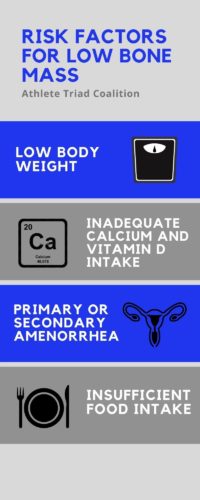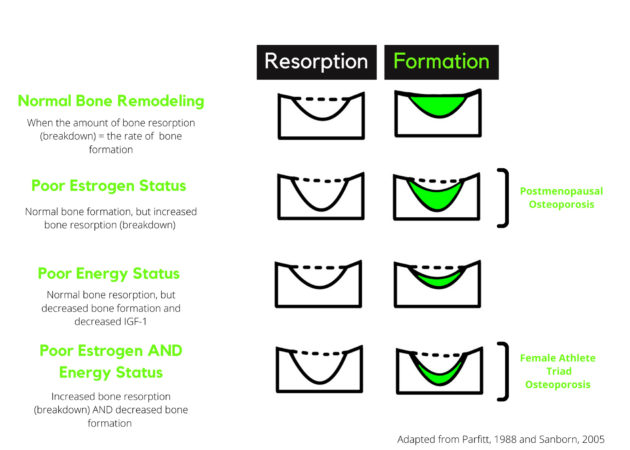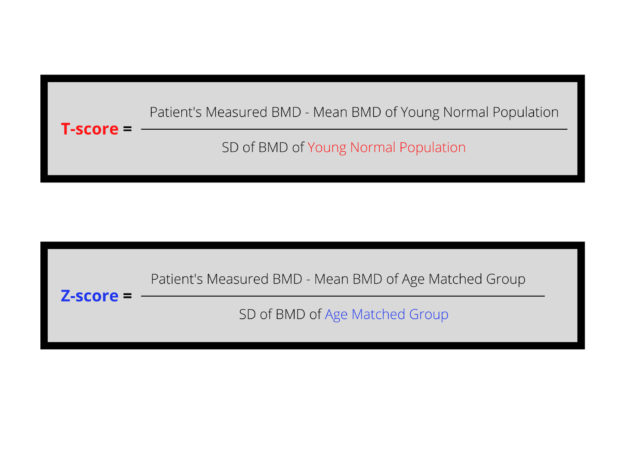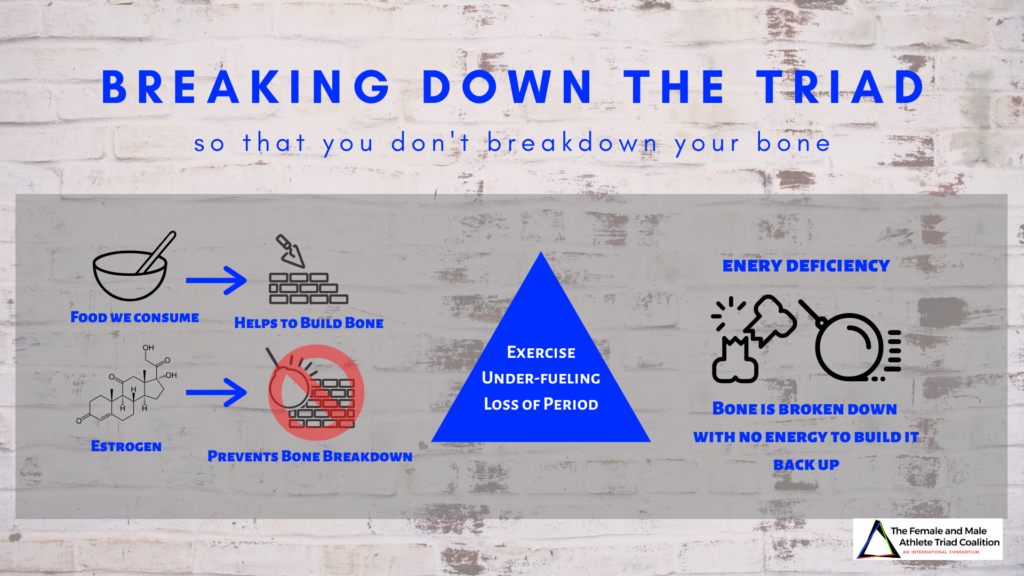
The Triad and Bone Health
Energy deficiency/ low energy availability detrimentally impact bone health. When a person does not eat enough food to supply energy needs for a healthy body, the energy needed to keep bones healthy is suppressed.
Hormones responsible for stimulating bone growth inhibited and a loss in bone mass can result from not having enough energy in the body. If energy deficiency persists, this can lead to stress fractures and osteoporosis.
Bone Health Consequences
Osteoporosis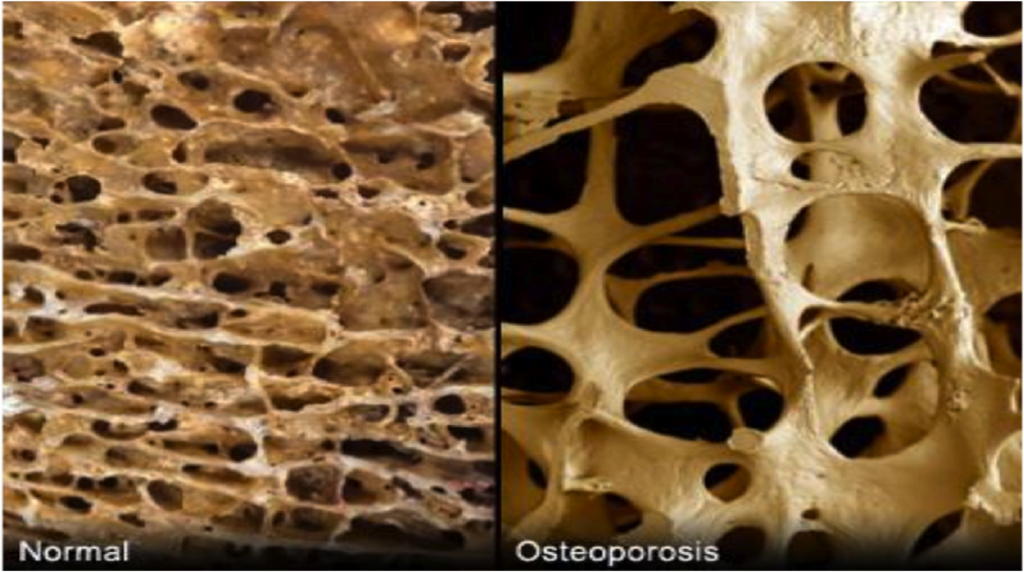
A disease in which the density and quality of bone is diminished, which in some cases can result from the low estrogen (an important hormone for maintaining bone), due to inadequate energy availability, or energy deficiency. Severe consequences of this disease include increased fracture risk, chronic pain, reduced mobility, functional long-term limitation, loss of independent living and an overall reduced quality of life. Importantly, osteoporosis can impact young exercising individuals in cases where chronic energy deficiency is left unchecked.
Stress Fracture/ Bone Stress Injuries
A stress fracture is a bone fracture that develops over time, often as a result of overuse, and it is important to remember that recurrent stress fractures or other bone stress injuries are never a normal response to exercise training.
Sustaining stress fractures or experiencing prolonged shin splints may be an indication that an individual’s bone health is compromised. While not all individuals who develop fractures or shin splints have the Athlete Triad, it is important to take a look at their diet and exercise habits to ensure that they are properly fueling their body and consuming enough calories, calcium, and Vitamin D.
Bone Basics
Bone is a living tissue and therefore, is constantly being renewed throughout life. At all times within your bones, old bone is being removed by bone cells called osteoclasts, and new bone is being laid down by bone building cells called osteoblasts. Although it may sound hard to believe, due to these processes, the entire human skeleton is completely replaced about every 7-10 years.
Bone Remodeling
Bone remodeling is the predominant process by which bone tissue is turned over via the couples actions of osteoclasts and osteoblasts. Bone remodeling is dominant in the non-growing skeleton whereas bone modeling is dominant in the growing skeleton and is responsible for the growth and expansion of developing bones.
- Osteoclasts: responsible for bone resorption, and continually breakdown bone
- Osteoblasts: responsible for bone formation, and continually build new bone
Bone Remodeling Varies Based on Energetic and Hormonal Status
How to Assess Bone Health and Measure Bone Mineral Density
Bone mineral density (BMD) assessment will yield results on the strength and density of an individual’s skeletal system. BMD is measured using a DXA (Dual-Energy X-ray absorptiometry) scan which uses x-ray beams to measure the absorption of the beams by the bone. DXA provides measurement of bone mineral mass per area (g/cm^2).
Diagnosis of Osteoporosis via DXA Scan
T and Z-scores are used to allow comparison of BMD to others.
- T-Scores: used for comparison to a normal, young population’s BMD
- Z-Scores: used for comparison of BMD to an age-matched group
- Z-Scores are preferred when analyzing the BMD of women prior to menopause, and in males younger than 50
- Z-Score Meanings:
- Z-Score of -2 or lower is defined as “below the expected range for age”
- Z-Score above -2 is defined as “within the expected range for age”
How to Build Strong Bones and Keep Them Healthy
Peak bone mass is reached around age 18 in women and age 22 in men, so it is essential to act early when it comes to building and maintaining strong bones. The higher peak bone mass is, the lower the risk for developing osteoporosis and fractures later in life.
Factors that Influence Peak Bone Mass
- Nutritional Factors:
- Energy Intake (amount of calories consumed)
- Vitamin D
- Essential for calcium absorption
- Sources include sunlight, Vitamin D fortified foods, and fish oils
- Calcium
- In addition to its role in bone health, calcium is needed for muscle contractions, blood vessel contractions, and secretion of hormones and enzymes
- Sources of calcium include dairy, eggs, dark leafy green vegetables, beans, fish, calcium-fortified food, and supplementation
- Protein
- Sources of protein include beef, chicken, turkey, eggs, tofu, soy beans, nuts, fish, and dairy
- Hormonal Factors:
- Sex Hormones
- Estrogen (inhibits bone breakdown)
- Testosterone (anabolic, bone building affects)
- Cortisol
- Increased cortisol can lead to decreased bone health
- IGF-1
- Stimulates bone formation
- Growth Hormone
- Stimulates bone formation and growth
- Parathyroid Hormone (PTH)
- Calcitonin
- Sex Hormones
- Genetic Factors
- Mechanical factors:
- Physical Activity
- Body Weight
Tips to Keep Your Bones Healthy
- Eat a well-rounded diet and consume a variety of fruits and vegetables, whole grains, fats, and proteins
- Consume foods high in calcium and Vitamin D, and add supplementation is you aren’t meeting the recommended daily values in your diet alone
- Maintain a stable, healthy weight
- Avoid extreme diets
- Engage in regular exercise: Both strength training and weight-bearing exercise aid in building and maintaining strong bones
Strength Training:
- Examples Include:
- Weight Lifting
- Body weight, strength-based exercises such as pushups and squats
- Weight-bearing exercise:
- Examples Include:
- Jump Roping
- Walking/Jogging/Running
- Many sports such as soccer, basketball, and tennis
- Dancing
- Examples Include:


